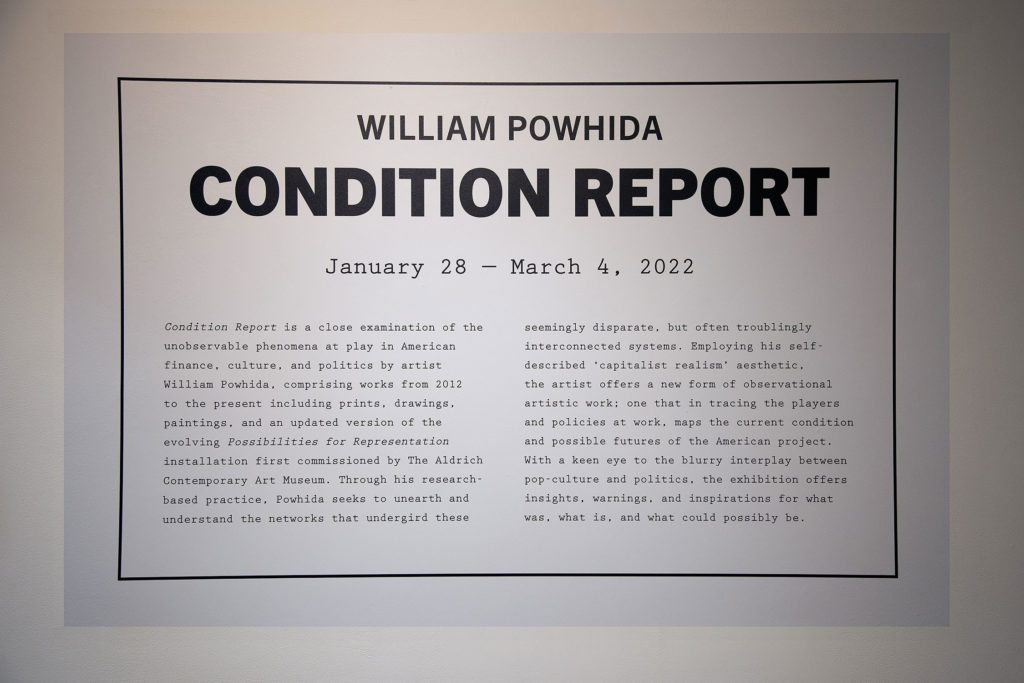The best way to prepare for the future is to understand the past. Supported by the John B. Hurford ’60 Center for the Arts and Humanities, the Cantor Fitzgerald Gallery’s latest exhibition, Condition Report, features a collection of artist William Powhida’s prints, drawings, and paintings and lines representing connections between them to map the history of American politics, finance, and culture to assess America’s current political and economic systems and predict what the future will bring. The exhibition, which opened Jan. 28, will run through March 4.
Each of the eight artworks in Condition Report focus on the history of different American systems. Powhida’s 2019 piece Neoliberalism (Policy) details the evolution of the role of the executive office in promoting policies of privatization from the Reagan administration to Trump’s four-year term. The 2012 artwork Griftopia, inspired by Matt Taibbi’s 2011 book, visualizes the complex flows of wealth, debt, and regulatory decisions that led to the 2008 global financial crisis. The Contemporary, created in 2019, charts a timeline of social and political struggles, technology advancements, and art trends with the rising share of national income by the top 10%. Powhida’s 2020 installation Possibilities for Representation intertwines historical political narratives from across the American political party spectrum.
In his work, Powhida demonstrates the power that wealth has in shaping the country by illustrating the intersections of different sectors of power, such as politics and pop culture. He evaluates the overlapping the administrative power of politicians to celebrities who have social influence, whether through their presence in media like Denzel Washington (who portrayed Malcolm X in the 1993 biopic), Oprah Winfrey, and Tucker Carlson, or through explicit political aspirations like Dr. Oz and Kanye West, who have both shown interest in running for a position in office. Regardless of profession, those with money are the most influential in shaping the future of the country.
By mapping out different American systems, Powhida offers his forecast of the future, one that will likely include further political corruption, wealth gaps, and devastating natural disasters due to climate change. “Unfortunately, I’m not particularly optimistic or hopeful for the future based on past and present conditions,” said Powhida at an artist talk about the exhibition on Feb. 3 via Zoom. “But none of these are inevitable, they’re all indicated with dotted lines. These kinds of systems and structures that we both help shape and construct every day also shape and influence us, and that happens through the kind of stories we choose to share and tell about the world.”
Students found connections between the subject matter of the exhibition and the topics covered in their coursework. “The piece from the show that first caught my attention was The Sacklers (Family Tree),” said Amolina Bhat ’23. “Most recently, my ‘Sociology of Art’ professor mentioned the Sacklers as we were reading some of [Pierre] Bordieu’s work (who is actually also mentioned in the wall text for this piece). We have since spent some time discussing Bordieu’s notions of social and cultural capital and the influence one can have on the ‘art world’ if one holds a lot of such capital. Powhida’s piece beautifully pulls together and highlights the particular lines of influence of the Sacklers through portraiture and hand-painted quotes. I would highly recommend checking it out if you want to learn more about the family’s legacy and ties to both the art and pharmaceutical worlds. You might be surprised by how many organization names you recognize!”
Matthew Callinan, the associate director of the Cantor Fitzgerald Gallery and campus exhibitions, played a vital role in bringing Powhida and his work to the Cantor Fitzgerald Gallery.
“I was connected with William via one of his gallerists, Charlie James, whom we worked with in 2017 on Sadie Barnette’s Dear 1968,… exhibition,” he said. “At first the intention was to focus solely on the large-scale installation work Possibilities for Representation, but William and I worked to open things up a bit more, providing a broader context to his work by including previous works from 2012 onward that resonated with the Possibilities work. With Possibilities as the centerpiece a lot of energy was focused on that work, and William created numerous new drawings to update and expand the installation from its three previous iterations including new works that are specifically relevant to Philadelphia and Pennsylvania.”
With the endless possibilities in civil and political discourse, as well as the upcoming fall elections, Callinan believed this was the perfect time to bring Condition Report to campus. “My favorite part of this exhibition, as it is with all of our exhibitions really, are the conversations that are made possible by the presence of the artwork in the gallery. William has really opened up many rich topics for discussion, as highlighted by his artist talk on February 3, and I’m excited for those conversations to continue for visitors throughout the run of the exhibition and beyond.”






